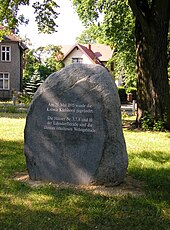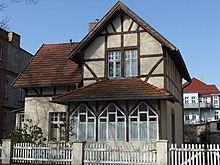Prince's Quarter
The Prinzenviertel is a residential area in the southwest of the Berlin district of Karlshorst . It got its name due to the allocation of street names after six sons of the German Emperor Wilhelm II.
history
In 1893, the construction association Eigenhaus was founded under the direction of the lawyer Otto von Hentig , the Count August von Dönhoff-Friedrichstein and the paper manufacturer and councilor Max Krause . It was formed in order to acquire building land and to enable housing developments on favorable terms for the less well-off. She acquired a 60 hectare site that encompassed the southern parts of the Treskow district of Friedrichsfelde on both sides of the Lower Silesian-Märkische Railway .
Together with the Eigenhaus construction association , the Heimstätten-Actien-Gesellschaft was founded, which entered the land in the land register for the master builder and Friedrichsfeld community representative Oscar Gregorovius and gave him the business powers for negotiations with the authorities and the development planning.
Gregorovius took over the development and development of the new Carlshorst settlement west of Kaiser-Wilhelm-Strasse (today: Lehndorffstrasse) to the border of Rummelsburg . He designed a colony in a simple, right-angled settlement plan with almost the same size plots. He secured the gas supply from the Oberspree gasworks and the drinking water supply from the Triftweg waterworks through contracts.
On May 28, 1894, the foundation stone was laid for the first Carlshorster houses in Kaiser-Wilhelm-Strasse 1–3 (today: Lehndorffstrasse 2, 4 and 6). They came from a foundation of the imperial family and were given to needy families, especially railway employees from Friedrichsfelde. In 1943 the buildings were destroyed by an air raid.
The district administrator of the Niederbarnim Wilhelm von Waldow district signed the colony consensus of the future villa and country house settlement on May 25, 1895 . The day it was signed is considered the founding day of the Carlshorst colony (from 1901: Karlshorst). A memorial stone was erected in 1913 on the roundabout at today's corner of Wandlitzstrasse and Lehndorffstrasse, which had disappeared at the end of the war in 1945. On May 25, 2005, a new memorial stone was erected on the occasion of Karlshorst's 110th anniversary.
At the confluence of Kaiser-Wilhelm-Straße (today: Lehndorffstraße) and Prinz-Heinrich-Straße (today: Wandlitzstraße), the Kaiserpavillon, a separate station building for the Kaiser, was built in 1895 . It was used from 1897 for church services of both denominations and is therefore also known as a chapel . The building was demolished in 1930.
Initially, the Eigenhaus building association and the Heimstätten AG villa and country house building company only intended to improve the living conditions of workers, employees and lower civil servants by building small housing developments.
The exclusive residential use of the colony was specified in the land register . The establishment of factories or businesses that caused odors and noise was not permitted. With the increasing demand for building land at the end of the 19th century and the attractiveness of the suburb of Karlshorst with its favorable location on the horse racing track for obstacle races or hunting races, speculation was soon about more financially strong residents. From the turn of the 20th century onwards, with the construction of representative villas and apartment buildings, there was a change of mindset in the area of development. But also with these buildings, existing design elements such as low-storey open construction without rear buildings and side wings were included.
On October 7, 1910, the Friedrichsfelder elementary school (IV. Elementary school) was opened as a seven-class school on the property at Auguste-Viktoria-Straße 35 (today: Ehrlichstraße 63) . From 1921 it was called the 30th community school , from 1927 30th elementary school , from 1945 30th elementary school , from 1960 30th secondary school , from 1981 30th POS M. W. Lomonossow (after the Russian poet Michail Lomonossow ) and from 1991 to 2002 23rd elementary school Am Seepark . After ten years of vacancy and extensive renovations, the state-recognized Karlshorst creativity primary school moved into the building on February 8, 2003.
In 1913, the Seepark was created between Trautenauer Strasse and today's Liepnitzstrasse , including the Rohrlake flowing between the Wuhlheide and the Klingenberg power station . After 1945 rubble was dumped on the site and the facility leveled into a large lawn. In 1955, the Seepark was redesigned as a green area as part of the National Construction Works (NAW). In 1951, the Prinzenviertel was connected to the tram network by the newly opened line 82 (today: line 21) along Ehrlichstrasse .
State description
The Prinzenviertel is characterized by predominantly paved and tree-lined streets and paths, diverse buildings and gardens with recurring design features. They clearly document the preservation of the area, which is now over 100 years old, in the villa and country house style.
Of the buildings that still exist today, over 63 percent were built between 1894 and 1908, the first major construction phase of the settlement. Some of the country houses and villas are listed due to their importance and their original condition.
From 2019, two new residential complexes will be built on the edge of the Prinzenviertel: the Imperial Gardens on Wandlitzstraße and Parkstadt Karlshorst on Blockdammweg / Trautenauer Straße .
First built streets and their names
| Street name | Namesake | Family relationship | renaming |
| Kaiser-Wilhelm-Strasse | Wilhelm II. | from 1934 Lehndorffstrasse | |
| Auguste-Viktoria-Strasse | Auguste Viktoria | Wife of Wilhelm II. | from 1951 Ehrlichstrasse |
| Prinz-Heinrich-Strasse | Heinrich of Prussia | Brother of Wilhelm II. | from 1951 Wandlitzstraße |
| Prinz-Friedrich-Wilhelm-Strasse | Wilhelm of Prussia | 1st son of Wilhelm II. | from 1951 trotting path |
| Prinz-Eitel-Friedrich-Strasse | Vain Friedrich of Prussia | 2nd son of Wilhelm II. | from 1951 at Üderseestrasse |
| Prinz-Adalbert-Strasse | Adalbert of Prussia | 3rd son of Wilhelm II. | from 1951 Liepnitzstrasse |
| Prinz-August-Wilhelm-Strasse | August Wilhelm of Prussia | 4th son of Wilhelm II. | from 1951 Stechlinstrasse |
| Prinz-Oskar-Strasse | Oskar of Prussia | 5th son of Wilhelm II. | from 1951 Müritzstrasse |
| Prinz-Joachim-Strasse | Joachim of Prussia | 6th son of Wilhelm II. | from 1951 Grimnitzstrasse |
literature
- 100 years of Karlshorst. History of a villa and country house settlement. be.bra, Berlin 1995, ISBN 3-930863-02-2 .
Web links
- Conservation regulation for the lakes / prince district. District Office Berlin-Lichtenberg, Department of Urban Planning
Individual evidence
- ↑ Angela M. Arnold, Gabriele von Griesheim: rubble, railways and districts. Berlin 2002, ISBN 3-00-009839-9 , p. 118 ff.
- ↑ Development plan 11-57 "Wandlitzstraße"
- ^ Urban development guidelines Karlshorst-West / Blockdammweg
Coordinates: 52 ° 29 ' N , 13 ° 31' E


